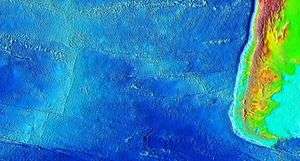Cura-Mallín Formation
| Cura-Mallín Formation Stratigraphic range: Upper Oligocene–Middle Miocene | |
|---|---|
| Type | Geological formation |
| Sub-units | Various schemes, see text |
| Underlies |
Cajón Negro Formation Mitrauquén Formation Trapa Trapa Formation |
| Overlies |
Cretaceous granitoids Jurassic sediments |
| Thickness | >1,800 m |
| Lithology | |
| Primary | Sandstone, siltstone, shale, breccia, andesite lava |
| Other | Grainstone |
| Location | |
| Region | Araucanía Region, Bío Bío Region, Neuquén Province |
| Country | Chile, Argentina |
Cura-Mallín Formation (Spanish: Formación Cura-Mallín) is a heterogeneous volcano-sedimentary formation of Oligocene-Miocene age in south-central Chile and nearby parts of Argentina.[1][2] The formation's sediments were deposited in a lake environment and alongide rivers in an intra-arc basin.[1] Southeast of Laguna del Laja Cura-Mallín Formation has a thickness of more than 1,800 m.[3]
The Cura-Mallín Formation has a north-south elongate form.[3] The formation is considered an equivalent of Abanico Formation, either as a southern extension or as a lateral equivalent of that formation.[3]
The formation contains abundant mammal fossils including Osteichthyan fishes, birds and mammals such as rodents, marsupials, Mylodontidaes and Notoungulatas.[3]
Stratigraphy and members
Various subdivision schemes have been advanced for Cura-Mallín Formation since the 1980s. In 1983 Niemeyer and Muñoz identified two members Río Queuco overlain by Malla Malla. In two publications published in 1995 and 1997 Suárez and Emperan divided Cura-Mallín Formation in two diachronous members: Guapitrío and Río Pedregoso. Utgé et al. (2009) proposed instead a subdivision into an upper Arroyo Pincheira Member and a lower Lumabia Member.[2]
Cura-Mallín Basin
A number of geologists consider Cura-Mallín Basin, the sedimentary basin where the formation deposited, an extensional basin that developed on the western fringes of the much larger Neuquén Basin, while others consider it a back-arc basin. In the Upper Miocene the sedimentary basin was inverted.[4] Relative to other nearby sedimentary basins of Miocene and Oligocene age Cura-Mallín Basin has been more researched.[5]
References
- 1 2 Suarez, M.; Emparan, C. (1995). "The stratigraphy, geochronology and paleophysiography of a Miocene fresh-water interarc basin, southern Chile". Journal of South American Earth Sciences. 8 (1): 17–31.
- 1 2 Utgé, Silvana; Folguera, Andrés; Litvak, Vanesa; Ramos, Víctor A. (2009). "Geología del sector norte de la Cuenca de Cura Mallín en las Lagunas de Epulaufquen, Neuquén". Revista de la Asociación Geológica Argentina (in Spanish). 64 (2): 231–248. Retrieved 4 August 2016.
- 1 2 3 4 Flynn, John .J.; Charrier, Reynaldo; Croft, Darin A.; Gans, Phillip B.; Herriott, Trystan M.; Wertheim, Jill A.; Wyss, André R. (2008). "Chronologic implications of new Miocene mammals from the Cura-Mallín and Trapa Trapa formations, Laguna del Laja area, south central Chile". Journal of South American Earth Sciences. 26 (4): 412–423.
- ↑ Radic, Juan Pablo (2010). "Las cuencas cenozoicas y su control en el volcanismo de los Complejos Nevados de Chillan y Copahue-Callaqui (Andes del Sur, 36-39°S)". Andean Geology (in Spanish). 37 (1): 220–246. Retrieved 31 July 2016.
- ↑ Franzese, Juan R.; D'Elia, Leandro; Bilmes, Andrés; Muravchik, Martin; Hernández, Mariano (2011). "Superposición de cuencas extensionales y contraccionales oligo-miocenas en el retroarco andino norpatagónico: la Cuenca de Aluminé, Neuquén, Argentina". Andean Geology (in Spanish). 38 (2): 319–334. Retrieved 1 August 2016.
